|
GEORGE WHITE:
Toronto Star Newsboy Builds a Stairway to Broadway
(Part 2 of 2)
© Arthur E. Zimmerman and Betty Minaker Pratt
Out of Vaudeville and into Musical Theatre

|
|
Ryan and White in the cast of Charles Dillingham's singing and dancing frolic "The Echo", with Bessie McCoy, the Dolly Sisters and
Toots Paka and her Hawaiians (NYT, Aug. 14, 1910, pt. 6, p. 4). Dillingham's Globe Theatre had a sliding roof, which made it "the coolest theatre
in the world....Between the acts, Dillingham had the roof removed. The audience would have done it anyway with their applause"
(NYT, Aug. 21, 1910, pt. 6, p. 5).
|
|
|
The "Dancing Dandies" lasted four years, during which time they moved up from
burlesque into vaudeville and then into musical theatre, in "The Echo", a Dillingham-produced
musical comedy scored by Deems Taylor, at the Globe Theater: "Two youngsters, George White
and Ben Ryan, with their clogging, cut a good figure in their one brief specialty" (NYT, Aug 18,
1910, p. 9). "The big audience....rose to them, however, when after executing some pretty steps
with the Dolly Sisters, they broke into the maddest sort of syncopated clogging, now with two
legs almost continuously in the air, now whirling this way and now that, and ending with a step
that was carried through so swiftly that the dancers looked like one long centipede with a
hundred legs. This kind of dancing is practically new to the comic opera stage" (NYT, Aug. 21,
1910, pt. 6, p. 5). The number was likely "The Course of True Love" in Act 2 (Norton, Vol. 1, p.
941).
They quarreled, separated - perhaps the Dolly Sisters came between them or it may have
started as a battle over George's ambitions and his wanting to buy dress suits for the act
(Woolcott) - and White went solo, inheriting the trunk. He was in "La Belle Paree" (music by
Jerome Kern and Frank Tours), the third part of a musical extravaganza that opened the
Shuberts' Winter Garden Theatre, the former American Horse Exchange (NYT, Mar. 19, 1911,
pt. 7, p. 3), where Al Jolson's career took off after he stopped and stole the show. During the run
(NYT, July 31, 1921, pt. 6, p. 1), Jolson vaguely described a dance, which White developed into
his "Turkey Trot". White also claimed to have invented the "Black Bottom" and "Charleston".
Actually, what he did was to popularize them, since all three were gentrified and formalized in
several stages from jook-joint dances and steps probably seen by George in the streets and
theatres of Harlem. Incidentally, the Shuberts soon fired George (Kutner).

|
|
George White in the cast list of "La Belle Paree", part of a musical extravaganza which opened the Shuberts' new Winter Garden
Theatre in New York. Al Jolson quickly mobilized himself to steal the show every night, and that launched his career
(NYT, Mar. 19, 1911, pt. 7, p. 3)
|
|
|
George appeared in the original "Ziegfeld Follies" of 1911 (Norton, Vol. 1, p. 965),
generally surrounded by the indefatigable Dolly Sisters (V, July 1, 1911, p. 20). After the regular
show, however, came a third part called "The Barbary Coast" (i.e., San Francisco), a vaudeville
in which George, the young Fanny Brice and others danced (NYT, June 27, 1911, p. 9). White
was dropped from the "Follies" but was signed by Jacques-Charles to appear at the Olympia in
Paris for 1912-13 (Leslie, p. 198; V, Dec. 25, 1914, p. 104; NYT, July 31, 1921, pt. 6, p. 1).
Meantime, George was in "A Night with the Pierrots" starring Al Jolson and Ernie Hare, part of
"The Whirl of Society" at the Winter Garden. George expertly assisted the "very airy little sprite"
Kathleen Clifford "in a nimble dance"(NYT, Mar. 6, 1912, pt. 2, p. 11) and did "Hypnotizing
Man" with Laura Hamilton (Norton, Vol. 1, p. 985).

|
|
The earliest photo that we found of George White, when he was in the road company of "The Red Widow", about age 22
(TDS, Mar. 8, 1913, p. 5)
|
|
|
His big vaudeville duo-hit with "little mite" Minerva Coverdale opened first at the
Majestic in Chicago, where "Wynn" noted that if George could sing, the two "would eventually
become one of vaudeville's best double-acts. But with White's voice another improvement
would become necessary. Miss Coverdale would have to raise the percentage on her appearance.
The one and great feature is the dancing. And this couple can twist around in front of a drop a
little speedier than any pair who have rambled out this way....White's solo dancing was the life of
the offering...." (V, May 18, 1912, p. 14). At Hammerstein's in Manhattan, they were "one of the
best man and woman dancing acts in vaudeville", but just missing the mark of greatness. They
closed with the sensational new "Parisian Rag", a combination of the "Turkey Trot" and the
violent and sensual European "Apache", making them "eligible for the highest honors in
acrobatic terpsichoreanism"(V, June 15, 1912, pp. 16 & 18).
Then, over to Europe in the winter of 1912-13 where he danced with the Olympia Review
in Paris (V, Dec. 25, 1914, p. 104), was a featured dancer at the Hippodrome in Paris (TDS, Mar.
8, 1913, p. 5) and at some point he also danced at the Folies Bergères (TDS, May 26, 1928, p. 4).
It was there that he got acquainted with the revue à grand spectacle, which surely influenced him
later to hire Erté as costume and scenic designer for his "Scandals".

|
|
George White's Christmas / New Year greeting, with address, credits and future route list
(V, Dec. 25, 1914, p. 104)
|
|
|
He danced with Coverdale in a touring company revival of "The Red Widow", replacing
Harry Clarke as Oswald Butts, the juvenile lead. George helped develop Coverdale's dancing
technique (TDS, Mar. 8. 1913, p. 5) and they were repeatedly encored for their wonderfully
clever, skillful performances (ET, Mar. 4, 1913, p. 21; TW, Mar. 4, 1913, p. 8; G, Mar. 4, 1913,
p. 8; WT, July 8, 1913, p. 3). While at the Princess in Toronto, The Star recalled that George was
"once a dancing newsboy" (TDS, op. cit.). At some point, perhaps during that 1913 tour of "The
Red Widow", he taught a petite chorus girl, Anna Pennington, some intricate dance steps and
those lessons were her ticket to fame (Kutner). Quite soon afterward, she was featured in the
1913 "Ziegfeld Follies", where she stopped the show, and then starred in the 1914 and 1915
editions. Over the years, White and Pennington were very close, professionally and personally.
At one point, they were even rumoured to be engaged. They called each other "Penny" and
"Swifty" (SHJ, Oct. 1, 1935, p. 4).
White appeared as a solo dancer on the bill at the Palace in New York in the middle of
the 1913-14 season and again in 1915 (Cullen, p. 1194). He was in "Who's Who" at the Criterion
Theater (Sept. 11 to Oct. 1913) and in "The Pleasure Seekers" at the Winter Garden (Nov. 3,
1913 to Jan.3, 1914, under Lee and J.J. Shubert), where George walked away with the show two
or three times. His biggest hit and one of the successes of the show was "a clever dance on skiis"
(NYT, Nov. 4, 1913, p. 9), and that's where he first rose above the dancer classification (V, Nov.
7, 1913, p. 21). He was dropped into the lavish musical comedy "The Midnight Girl", starring
Margaret Romaine and Canadian baritone George MacFarlane, in mid-run in early 1914,
replacing Harry Delf as François (Bloom). Rumours that White was in "The Passing Show of
1914" did not check out (Norton, Vol. 2, p. 54).

|
|
Anna Pennington and George White in the cast of the 1915 "Ziegfeld Follies"
|
|
|
In 1914, George issued a Christmas and New Year message in Variety, with a list of
appearances, "a reason for the Following Consecutive Engagements", and giving his permanent
address as the St. Margaret Hotel, 127 W 47th Street, New York (V, Dec. 25, 1914, p. 104). He
also had billings with the United Booking Offices and Orpheum Circuits in 1914-15 (V, Dec. 25,
1914, p. 104).
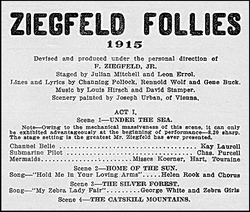
|
|
Part of the cover of the "Ziegfeld Follies" of 1915 program, at the New Amsterdam Theatre on 42nd Street. George White's
first appearance in the show was in Act I, dancing with the Zebra Girls in the first of two Silver Forest scenes.
|
|
|
White was engaged for the spectacular art-deco 1915 "Ziegfeld Follies" (the "Blue Follies")
at the New Amsterdam, appearing in "The Silver Forest" with the Zebra Girls, with star Bernard
Granville and the Cotton Girls in "America" and in "The Flirtation Medley Dance" with featured
Anna Pennington of the flashing legs, set in a 57th Street shop. Other stars were W.C. Fields, Bert
Williams and Ed Wynn. The White-Pennington "Medley Dance" was the best and the only
unusual dancing bit in the show (V, June 25, 1915, p. 15). When George went to Ziegfeld asking
for a raise or suggesting improvements, he was fired.
With Lucille Cavanagh at B.F. Keith's Palace, feather-footed White did a 16-minute
"routine that fairly shrieks originality in every split-second" and "a grade of dancing excellence
that tops anything of its kind ever seen at the Palace....Mr. White stands out as one of the best of
modern dancers....they took the hit of one of the best bills ever booked at the Palace". George
soloed in one spot, asking for requests to dance in different styles (V, June 23, 1916, p. 12). They
headlined at Shea's in Toronto, in a varied vaudeville program promoted as "A 1917
Presentation of Songs, Dances and Gowns" - the "Gowns" was a comedy sketch by Mrs. Gene
Hughes, not part of the White-Cavanagh dance act (G, Feb. 5, 1917, p. 7; TDS, Feb, 6, 1917, p.
7).
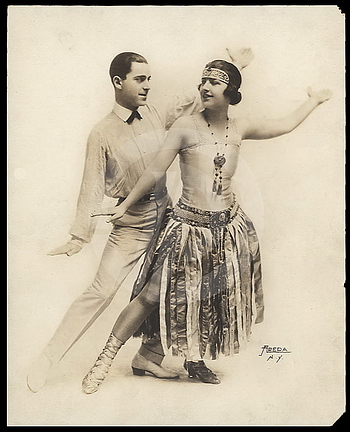
|
|
Publicity photo of George White and Lucille Cavanagh dancing in an unknown show, possibly in one of George's successful vaudeville acts in 1916-17
|
|
|
Ziegfeld engaged George again for the Jerome Kern-Victor Herbert-P.G. Wodehouse
revue "Miss 1917", as a principal with Ann (no longer Anna) Pennington, Irene Castle, Bessie
McCoy "Yama Yama" Davis, Marion Davies, Lew Fields and Van and Schenck. (NYT, Nov. 6,
1917, p. 11). George was featured in two scenes in the first act and in "A Dancing Courtship"
with Ann Pennington in Act 2 (Norton, Vol. 2, p. 131). The original Century Theatre program,
however, shows "A Dancing Courtship" in Act 1, Scene 4, Kern's Buck-and-Wing Melodrama
"The Honor System" with White and Pennington in Act 2, Scene 9 and the whole cast in the
finale "America" (HZG).
The dazzlingly creative rehearsal pianist was the young and little-known
George Gershwin. After "Miss 1917" premiered, Gershwin remained on salary as pianist for the
Century Sunday concerts. The first, on November 11, included Eddie Cantor, Fanny Brice, Van and
Schenck, Ann Pennington, George White and Bert Williams (Jablonski, p. 48). White later engaged
Gershwin to score the second to the fifth "Scandals", and those shows introduced some immortal
songs.
Part of George White's shtick was to impersonate celebrities dancing. The censor warned
him, when he asked the audience for suggestions: "There is no objection to having 'St. Vitus
Dance' called from the audience, but please do not attempt going through any St. Vitus
movements" (NYT, May 6, 1917, pt. 8, p. 6). During a scene-change wait in "Miss 1917", after
dancing with Ann Pennington and Emma Haig and several combinations, "a cruel fate made Mr.
White go into 'one' around midnight with imitations" of Fred Stone, Will Rogers and George M.
Cohan dancing. Variety called it "a catastrophe" (V, Nov. 9, 1917, p. 15). In fact, George's
"Dance Imitations" was listed in the program as Act 2, Scene 11, between the Movie Hospital
scene and the Seashore at Palm Beach scene (HZG).
We found a recollection that George was in the "Midnight Review" at the Century Grove
Rooftop, doing imitations of other dancers (HBC). Opening night reviews give the cast and
describe the show (V, April 12, 1918, p. 10; NYC, April 18, 1918, p. 12), and George White is
not included. But there is documentation that he was in that show (V, Sept. 6, 1918, p. 16),
perhaps hired later as a replacement.

|
|
Ann Pennington (1893 - 1971) in her shimmy-dancing costume. Female chorus dancers were categorized by height. The tall statuesque posers
were showgirls, the mid-sized were mediums and the small ones, like 4'10" Ann Pennington, were ponies. She started out in the chorus of the
1911 "Follies", was trained by George White and became very famous for her shimmy dancing.
|
|
|
George is also supposed to have produced some kind of "miniature review" (sic.), in
vaudeville, circa 1916-18. There are reports that he hired eight vaudeville-wheel beauties to do
this show (NYT, Oct. 12, 1968, p. 37; VO), and that this venture gave
him the courage to try a full-scale girlie and giggles revue. Ever since his Ziegfeld years, George
had been telling friends and colleagues that some day he was going to put on his own show like
that, and they told him that he was crazy (NYT, June 13, 1920, pt. 6, p. 1). We found "George
White and Company" doing a 23-minute miniature revue, a vaudeville two-a-day, at the Palace in
late 1918. He had four well-known Broadway "girls", Tot Qualters, Ethel Delmar, Dorothy St.
Clair and Lois Leigh, and he taught these showgirls to dance! "Mr. White is a resourceful
producer of high-class dancing turns, also a skilled dancing instructor....The quartet of young
women, their looks, style, clothes and dances recall the after-theatre shows....Special
inducements (to) leave Broadway were probably Mr. White teaching them to dance, giving the
girls an opportunity to individually glow before the footlight with 'lines' and salary. For White
seems able to make a dancer out of any girl. His present quartet are doing very well at it, one
particularly so, while another must still undergo some teaching....White also does his imitation
dances, sings, talks and gives the young women assistants a much wider chance to work than the
ordinary male star of a girl production would allow" (V, Sept. 6, 1918, p. 16). Here again, as in
so many documented instances before, George was teaching his colleagues, his dancing co-stars
and even his non-hoofer employees how to dance and to come up to his professional standards.
There are rehearsal reference films of him working on-stage with his chorus line, showing them
steps and turns. He was a tireless perfectionist, might work with his "girls" around the clock on
one step until they nailed it, and his teaching produced major dancing stars.
White and Company went on the road for the United Booking Office of New York,
turning up at the Riverside Theatre in New York in November: "George White, assisted by
(Qualters et alia), has what is without doubt the best dancing act he has ever presented. It runs
smoothly and fast from beginning to end and is thoroughly entertaining throughout. White is
doing some of the best dancing of his career, which is only another way of saying that he is one
of the best in the business. His imitations were remarkably well done, with the possible exception
that in most all instances he is a better dancer than the one he imitates" (NYC, Nov. 27, 1918, p.
7). The next week, they played the Orpheum in Brooklyn and then on to Shea's in Buffalo and
Shea's in Toronto (NYC, Dec. 11, 1918, p. 25), where the papers reported: "George White, with
four clever girls" in "a great bill of all-star acts" (G, Dec. 12, 1918, p. 6; TDS, Dec. 14, 1918, p.
28).

|
|
George White and some of the prettiest of the Scandal Mongers, on stage in the "George White's Scandals of 1919"
|
|

|
|
George White and Ann Pennington, in their Flirtation Dance in the "George White's Scandals of 1919". An earlier version
of the same dance was a big hit in the 1915 "Follies".
|
|
|
George White's Scandals
After the success of this "miniature review", George figured that he knew how to out-do
Ziegfeld and the Brothers Shubert in a big show, and at a much lower cost: "I thought it was
kind of a simple thing to stage a show. All you needed was the money" (TDS, Mar. 29, 1965, p.
42). He had only $12,000 in cash and could earn $1,500 a week performing (NYT, Dec. 19,
1926, pt. 7, p. 4), but is said to have raised another $35,000 in credit from a scenic studio and a
costumer (NYT, July 31, 1921, pt. 6, p. 1). "Scandals" was apparently the first revue composed
and written by a team, music by Richard Whiting and Herbert Spencer, book and lyrics by Arthur
Jackson and George White (Bloom). One story is that the name "Scandals" was suggested by a
shocked maiden aunt, but George responded to a question on CBC-TV that the name was topical,
that there were quite a few scandals happening in New York, such as divorces in Long Island and
women killing their husbands (Flashback).

|
|
Advertisement for opening night of the "George White's Scandals of 1919" at the Princess Theatre, Toronto
(TDS, Nov. 26, 1919, p. 27)
|
|
|
The only star he could afford was elfin Ann Pennington, the flashing, dark-haired beauty
whose intricate stepping he had helped to guide back in the days of "The Red Widow" tour
(Kutner). He also had Delmar, Leigh and St. Clair from the "miniature review". The rest were
tried and true out-of-work vaudevillians. White and bare-kneed shimmying cutie Pennington
received great applause on the first night, the NYC thought the show had beautiful girls, flimsy
costumes and enough snap and ginger (NYC, June 4, 1919, p. 28).
Variety thought it a
vaudeville-like dancing revue, noted a sparse second-night audience and thought that the show
lacked comedy, even from the comedians: "White is reputed to have plunged with his own
capital to the extent of $40,000, and 'Scandals' looks it" (V, June 6, 1919, p. 15) - hardly a rival to the upcoming "Ziegfeld Follies".
The Times liked the costumes and girls, but regretted the too-heavy, pointless satire and the lack
of "kick" and wit (NYT, June 3, 1919, p. 9). Burns Mantle's
review was bad - it actually made George cry (TST; Kutner). The legend is that George took over
as director, told off the cast, worked with a pile of old joke books that very night (or the next
afternoon) and re-wrote the whole show (Kutner; NYT, July 31, 1921, pt. 6, p. 1; MJ, Sept. 14,
1946, p. 13). Variety disclosed in the second week that "Show may be rewritten" (V, June 13,
1919, p. 16).

|
|
George White's advertisement for 100 beautiful girls, 16 to 21, for the next edition of the "Scandals". White specified that no
stage experience was necessary and that he would teach those engaged to dance without cost or expense.
|
|
|
By early July, reports were that "Scandals" had picked up with surprising strength
over the month (V, July 4, 1919, p. 13), that performance was improving all the time, that the
show was doing steady good business and was making money (V, July 11, 1919, p. 14). George
had turned "Scandals of 1919" into a success (Kutner; NYT, Dec. 19, 1926, pt. 7, p. 4). The
show was closed by the actors' strike, and George was able to pick up afterward only with a loan
of $8,000 from Sam H. Harris, the producer (NYT, July 31, 1921, pt. 6, p. 1).
After the New York run, the fast-paced "Scandals" went on tour and was a huge success
in Philadelphia. He brought it to the Princess in Toronto (TDS, Nov. 24, 1919, p. 17) with peppy
Ann Pennington of the dimpled knees and "50 Beautiful Scandal Mongers". The Toronto papers
were very cautious and the reviews were brief (TW, Nov. 25, 1919, p. 9; TSW, Nov. 22, 1919, p.
25). By the end of the tour, the show had made a profit of well over $100,000. George, however,
gambled away all of his profits and had to start planning the second edition with little money.
(NYT, Dec. 19, 1926, pt. 7 p. 4).
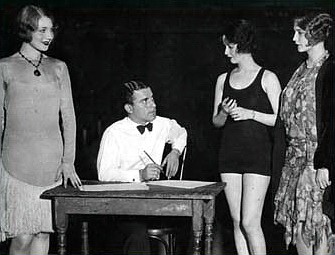
|
|
George White auditioning showgirls. George was looking for legs and sometimes did not do auditions, since he knew that he could
teach almost anyone to dance. When teen-age Dolores Costello appeared for an audition, George merely asked her when she wanted to start (AD).
|
|
|
George Gershwin sought out White in Detroit to ask for the commission to write the
music for the 1920 edition of "Scandals" (another story has White and Paul Whiteman
interviewing Gershwin for the 1920 "Scandals" in the steamrooms of the Manhattan Men's Club,
Gershwin being fully dressed), and he stayed on to write the music for the next four (Ewen).
In all, Gershwin supplied 45 songs to 5 "Scandals", 7 to the 1920 edition. Songs that came out of
White's shows were "Life is Just a Bowl of Cherries", "Charleston", "Black Bottom", "Birth of
the Blues", "The Thrill is Gone" and Gershwin's "Scandal Walk", "I'll Build a Stairway to
Paradise", "Drifting Along with the Tide" and "Somebody Loves Me".
White gets credit for
discovering, nurturing and promoting George Gershwin as well as Alice Faye, Ethel Merman,
Kate Smith, Ann Miller, Ray Bolger, Eleanor Powell and Dolores Costello (NYT, Oct. 12, 1968,
p. 12; Flashback), and over the years his other stars included Rudy Vallee, Helen Morgan, Ann
Pennington, Winnie Lightner, Harry Richman, Lester Allen, Ed Wynn, Bert Lahr, Ben Blue, the
Stooges, Jimmy Durante and W.C. Fields. Reviewing the 1922 edition, Alexander Woolcott
called "This current hub-bub at the Globe....a multi-colored, eye-disturbing ear-filling musical
show...." (NYT, Aug. 29, 1922, p. 18). In 1965, George was asked if the stars were difficult to
work with and how he could afford such top stars. He replied that they weren't stars when he
knew them. He discovered people before others did and got them for low prices (Flashback;
TDS, Mar. 29, 1965, p. 42).
What Else Can We Say about George White?
We found four birth dates for George White: 1890 (obituary in VO); March 15, 1891 (Victoria Public School Register, 1899, TDSBA); April 15, 1891 (CC
1901); March 12, 1890 (U.S. Social Insurance records; Pierce Brothers Valhalla Memorial Park,
North Hollywood, California). His birth place was given variously as Manhattan, Austria and
Toronto.
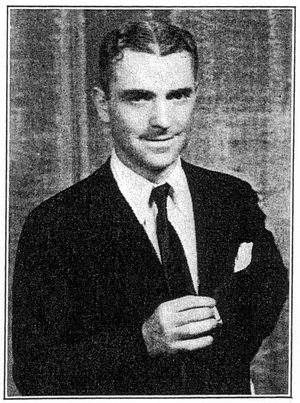
|
|
George White with his ever-present Fatima cigarette
(Time, Jan. 6, 1936, p. 24)
|
|
|
His obituary in Variety called him "the cocky bantam type, familiar to showbiz. He had
showmanly instincts but a limited education" (VO). By eighteen, George
had reached his full height of 5-foot 7-inches, weighed 140-150 pounds, had brown eyes and
black hair (PPG, Aug. 8, 1933, p. 13) and was restless, very intense and decisive, as one can see
in the Fox film "George White's 1935 Scandals". He ate very slowly - it took him an hour to eat
a sandwich (TST) - walked quickly and chain-smoked Fatimas (PPG, Aug. 8, 1933, p. 13). Rudy
Vallee said that George "rode" him (TDS, Dec. 12, 1935, p. 24), that he terrorized his players,
was difficult to work for and was extremely nervous and jumpy. George right-punched Rudy
Vallee (then President of the American Federation of Actors) in the nose for refusing a 50% pay
cut when attendance was falling off in "Scandals" (TDS, March 21, 1936, p. 1). In Milwaukee,
George was remembered by theatre men "as a temperamental, crabby fellow, hard to get along
with, quick to fine an actor for an infraction". Also quite unpredictable - he would suddenly "take
the notion to bounce onstage as M.C. and do a monologue" on himself. The next show, he was
nowhere to be found (MJ, Sept. 14, 1946, p. 13). He enjoyed playing practical jokes on his stars -
he would shoot elastic bands at his actors on stage, endangering the whole scene (PPG, Aug. 8,
1933, p. 13) - and he delighted in slipping into the box office to sell tickets. Especially to
strangers who demanded good tickets because they knew George White. He always hoped that
Flo Ziegfeld might turn up so that he could tell him, "Standing room only". Close friends said,
however, that White was shy and introverted (Bloom). Incidentally, because of the heat in the
confines of the box office, he would often remove his tuxedo trousers (VO).
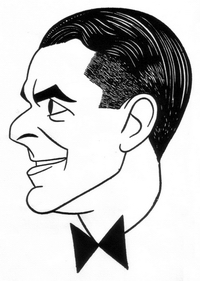
|
|
George White caricature, circa 1930 (TST). "He has never married. ‘I'm independent and nobody can keep tab on what I do.
I like it. And with any luck I'll beat this marriage rap to the end' " (TWM, Jan. 6, 1936, p. 24). In 1926, he said that he
had given up on the ponies (NYT, Oct. 12, 1968, p. 37) - he told Nanette Kutner, "Stick to women. They're safer than horses."
(NYEG, Sept. 20, 1924)
|
|
|
George was a compulsive gambler, the seeds likely planted in his early days in Toronto,
well before he and brother William were arrested under the Gaming Act (PRC; CTA). On tour in
Bridgeport, Ct., (V, Feb. 20, 1909, p. 23), he pulled a pistol in a dispute over stud poker in a
prominent Waterbury hotel and strode away with large wads of cash. He first told the press that
the gun was from his stage trunk and wasn't loaded. Later, he reconsidered and said that the thing
was actually a cigar lighter (BH, Feb. 28, 1909, p. 10). George gambled away all of his profits
from the first three "Scandals" - after the tour with the third edition, he returned from the track
with $600 to his name and huge debts. He claimed to have won over $400,000 on one pony, but
was said to have bet $100,000 at the track in a single afternoon (NYT, Dec. 19, 1926, pt. 7, p. 4;
SHJ, Oct. 21, 1936, p. 4). On five minutes consideration and just before leaving for Europe,
George bought a swank Park Avenue apartment house (but continued to live on 7th Avenue since
his Park Avenue rents were too high). Every February, he took his annual trip to Paris to plan
costumes, sets and draperies with Erté and brought back silly, costly gifts for friends and
mechanical toys for himself. He spent money with a dizzying recklessness (MJ, Sept. 14, 1946,
p. 13), was often broke and was in and out of bankruptcy several times - he estimated that he had
made and lost four million dollars in his career, a clear three million by 1929 (TDS, Mar. 29,
1965, p. 42; VO). Through all the financial ups and downs, he continued to
support his mother, Lena, in Toronto (NYT, Oct. 12, 1968, p. 37).
Our intention was to focus on and try to document George White's life and career up until
his first success with his "Scandals" in 1919. He put on twelve more editions of "Scandals" after
1919 plus several book shows, until the public began to lose interest in the girlies and giggles
format by the late 1930s. George tried to revive his "Scandals" in smaller venues, niteries and
restaurants and a third "Scandals" film was made in 1945, without George in the cast. He never
managed to recapture the public interest for long and died of leukemia in Mount Sinai Hospital,
Los Angeles, October 10, 1968 (VO; NYT, Oct. 12, 1968, p. 37; TDS, Oct. 11, 1968, p. 1).
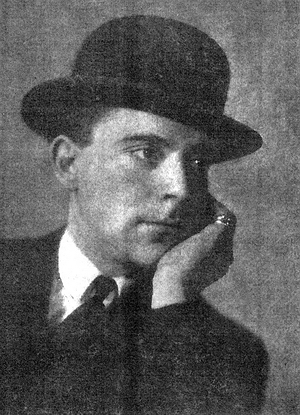
|
|
A pensive George White in bowler hat, circa 1927 (Kutner)
|
|
|
What Became of Hermann, Lena and Children?
We have not found Hermann's obituary or burial, and can only assume that he died circa
1912, since Lena was listed as a widow in the MCTD in 1913 and in Jacob's belated birth
registration in May, 1913. Lena died in 1938 (as Lena White, TDS, June 6, 1938, p. 29; ibid.,
June 7, 1938, p. 2) and is buried as Lena Weitz in Section 1, 101-14-36, the Dawes Road
Cemetery, Toronto. Daughter Rose and husband Mendel Gebirtig are buried nearby, in the same
section.
We may have found brother Adolph Weitz and sister Rose, arriving at Ellis Island from
Galicia, May 25, 1896, aboard the Veendam. We found Adolph in the USC, 1900 -1930, a barber
in Manhattan, with wife Sadie. They had four children and were still in Manhattan at the time of
Lena's death in 1938. Rose Weitz married Mendel Gebirtig, and they ran the Blue Bell Theatre
for years at Parliament and Dundas in Toronto. Their son, Sol Gebirtig, was a well-known lawyer
in Toronto. Mendel died on August 4, 1936 and Rose on November 25, 1970, age 92. Brother
Benjamin was drafted in San Francisco in 1917, and is in the USC there, a tailor, 1910-1930.
William, a professional boxer living in Chicago, claiming to have been born in New York City,
April 2, 1885, was examined December 18, 1917, in Toronto and taken into the Canadian
Overseas Expeditionary Force in Forestry and Railway Construction. In 1938, he was living in
Toronto. Sister Gertrude married Jacob Aber, a tailor, and they lived in Toronto, though we
found them crossing the border at Detroit several times. Predeceased by her husband, Gertrude
died around 1938. We found young Jacob Weitz transferring from Ogden School to Victoria and
back to Ogden in 1908, debarred from entering the U.S. at Lewiston in 1915 and 1919,
subtracting two years off his age when he married Norma Robinson in Toronto, March 2, 1917,
and in 1938 he was in New York. Mrs. Mary (Weitz) Filger and husband Morris lived in
Cincinnati in 1920 (USC) and Chicago in 1938. Mrs. Helen (Weitz) Gilbert was in Los Angeles
in 1938 and Miss Jean (Jenny) White lived in New York.
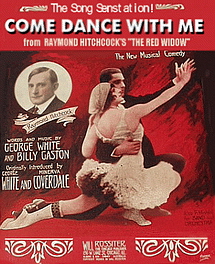
|
|
Sheet music cover of the song sensation "Come Dance with Me", words and music by George White and Billy Gaston, from "The Red Widow".
George White is shown dancing with Minerva Coverdale, probably on the road tour (1913).
|
|
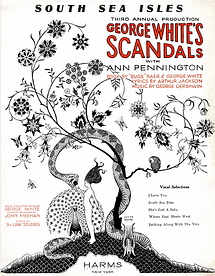
|
|
Sheet music cover for "South Sea Isles" from the 1921 (3rd) edition of "George White's Scandals", music by George Gershwin and words
by Arthur J. Jackson. The book was by "Bugs" Baer and George White.
|
|

|
|
Ann Pennington on the cover of the sheet music for "What d'Ya Say?", from the 1928 (9th) edition of "George White's Scandals"
|
|
|
George White on Screen:
Nertz (Fox; 1929)
George White's Scandals (Fox; 1934)
George White's 1935 Scandals (Fox; 1935)
George White's Scandals (RKO; 1945) - played by actor Glenn Tryon
Rhapsody in Blue (Warner; 1945)
CBC-TV's "Flashback", March 28, 1965 (TDS, Mar. 29, 1965, p.42)
Recordings of "Scandals":
Four songs from the 1921 "Scandals" and one from 1924, recorded by Paul Whiteman, were
published on CD in 1998 by David Lennick on "Paul Whiteman's Gershwin", NAC 4002.
Gershwin recorded several piano rolls of songs from the 1921 "Scandals", and three were once
available on an Elektra-Nonesuch CD, 79287-2.
|

|
South Sea Isles, introducing She's Just a Baby
Victor 18801
Recorded August 30, 1921
|

|
When Buddha Smiles, introducing Drifting Along with the Tide
Victor 18839
Recorded October 27, 1921
|

|
I Found a Four-Leaf Clover
Victor 18950
Recorded September 1, 1922
|

|
I'll Build a Stairway to Paradise
Victor 18949
Recorded September 1, 1922
|
|
|
Thanks to:
Lee Ramsay of the Theatre Collection, the 4th floor genealogy staff and Sheila Fairley of the
periodicals staff (Toronto Reference Library), Lawrence Lee (City of Toronto Archives), Dr.
Ellen Scheinberg (Ontario Jewish Archives), Dawes Road Cemetery, Jones Avenue Cemetery,
Sue Henderson (Interment Rights & Records, Mount Pleasant Group), Toronto District School
Board Archives, Barbara (Gebirtig) Ash, Mandella (Gebirtig) Turchen, Dr. Norton Taichman,
the Detroit Public Library, Dr. Sally Gibson and WEG.
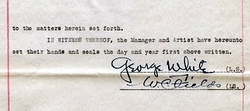
|
George White's signature on a contract with W.C. Fields, signed by both on June 21, 1922. Fields agreed "to render services as a
comedian (in) George White's Scandals for the 1922-23 season". Fields also wrote, in his own hand and initialed "W.C.F.", "add-/shall
not go on before 9' O'Clock". The comedian received $900 a week for his services.
|
|
|
References:
|
AD
|
"A Delightful Little Scandal" by Caleb F. Howard, in The American Dancer, Oct. 1928, p. 9
|
|
ALE
|
Ancestry, Library Edition, on-line - Ancestry.com
|
|
BH
|
Bridgeport Herald, Bridgeport, Connecticut
|
|
Bloom
|
Broadway, its History, People and Places - An Encyclopedia by Ken Bloom; Routledge,
New York, 2004, p. 555
|
|
BRC
|
Biography Resource Center, on-line - http://galenet.galegroup.com/
|
|
CC
|
Canadian Census
|
|
CTA
|
City of Toronto Archives
|
|
Cullen
|
Vaudeville Old and New: An Encyclopedia of Variety Performers in America, by Frank
Cullen; Routledge Taylor & Francis Group, New York, 2007, p. 1194
|
|
ET
|
Evening Telegram, Toronto, Ontario
|
|
Ewen
|
George Gershwin: His Journey to Greatness by David Ewen; Prentice-Hall, Inc., New
York, 1970, p. 60
|
|
Flashback
|
Canadian Broadcasting Corporation television program, March 28, 1965
|
|
G
|
Globe, Toronto, Ontario
|
|
HBC
|
"The History of Bobby Clark and Paul McCullough" by Michael D. Brick in "The Clark
and McCullough Database", on-line, 2006
|
|
HS
|
Hamilton Spectator, Hamilton, Ontario
|
|
HZG
|
Historical Ziegfeld Group, on-line - http://ziegfeldgrrl.multiply.com - click on "Miss
1917"
|
|
Jablonski
|
The Gershwin Years by Edward Jablonski and Lawrence D. Stewart, Doubleday &
Co., Garden City, N.Y., 1958
|
|
Kutner
|
"The Hoofer Who Became a Producer" by Nanette Kutner, Theatre Magazine, XVVI
#316, p. 22, July 1927
|
|
Leslie
|
A Hard Act to Follow: A Music Hall Review by Peter Leslie; Paddington Press, Ltd.,
New York, 1978
|
|
MCTD
|
Might's City of Toronto Directory
|
|
MJ
|
Milwaukee Journal, Milwaukee, Wisconsin
|
|
Norton
|
A Chronology of American Musical Theater by Richard C. Norton; Oxford University
Press, Oxford, 2002 (NOTE: A George White appeared in "Captain Rufus" and "The
Husband" at the Harlem Music Hall, the weeks of August 12 & 19, 1907, but the
company was the Pekin Stock from Chicago, "one of the best of the coloured companies"
(NYC, Aug. 17, 1907, p. 700).
|
|
NYC
|
New York Clipper
|
|
NYEG
|
New York Evening Graphic, New York City
|
|
NYT
|
New York Times, New York City
|
|
PRC; CTA
|
Police Register of Criminals, City of Toronto Archives, Access #141489 and
#141490
|
|
PPG
|
Pittsburgh Post-Gazette, Pittsburgh, Pennsylvania
|
|
RE
|
Reading Eagle, Reading, Pennsylvania
|
|
SHJ
|
Spartanburg Herald-Journal, Spartanburg, South Carolina
|
|
Stearns
|
Jazz Dance: The Story of American Vernacular Dance by Marshall Winslow Stearns
and Jean Stearns; The Macmillan Company, New York, 1968
|
|
TDS
|
Toronto Daily Star, Toronto, Ontario
|
|
TDSBA
|
Toronto District School Board Archives
|
|
TST
|
"George White: School for Scandal" in Times Square Tintypes by Sydney Skolsky; Ives
Washburn, New York, 1930, page 29
|
|
TSW
|
Toronto Star Weekly, Toronto, Ontario
|
|
TW
|
Toronto World, Toronto, Ontario
|
|
TWM
|
Time, The Weekly Magazine
|
|
USC
|
United States Census
|
|
V
|
Variety
|
|
VO
|
Variety Obituaries, Vol. 6, Oct. 16, 1968
|
|
Woolcott
|
"The Rise of Swifty White" by Alexander Woolcott, Collier's Magazine (U.S.), May
19, 1928, p. 12
|
|
WT
|
Winnipeg Tribune, Winnipeg, Manitoba
|
|